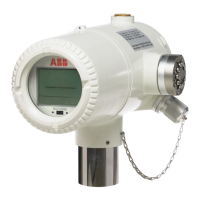2101510MNAH | NGC8200 AND PGC1000 USER MANUAL | 125
To troubleshoot stream pressure:
1. Perform the Sample pressure test (see section 11.3.2) for the sample vent. If the test fails,
proceed to the next step.
2. Perform the feed-through assembly blockage test (see section 11.3.3) on the sample vent
(SV). If the test fails, replace the feed-through assembly with a new or refurbished assembly.
3. Replace the analytical module.
4. Replace the GC Module.
11.2 Troubleshooting Alarms
IMPORTANT NOTE: The information provided for troubleshooting alarms is only intended to cover
basic steps that can be performed in the field. Additional troubleshooting steps may be provided by
technical support in an effort to reduce down time. Additionally, it may be desirable to return a
module to ABB for testing and/or repair.
This section focuses on determining what has caused an alarm following normal operation. The
analyzer has a built-in list of alarms, some of which are user-configurable. These alarms are grouped
into four areas: general, warning, fault and system fault. Table 11-4 lists enabled alarms. To view all
the available alarms, select Setup under Stream 1 on the Analyzer Operation screen and select
Alarm Definitions.
Additional alarms may be enabled but are not included here for the purposes of troubleshooting. They
are: component high/low concentration, component peak not found, and component RF limit
exceeded. These alarms are disabled by default. See the PCCU32 help files for more information.
Table 11-4: Default alarms
Description Enabled Type Severity
Pressure Regulator 1 Yes GT Fault
Pressure Regulator 2 Yes GT Fault
Sample Pressure Yes GT Fault
Calculation Error Yes GT Fault
Calibration Un-Normalized Total Yes GT Fault
Stream Sequence Error Yes GT Fault
Calibration CV Percent Error
Analog Bd Ambient Temp Yes GT Warning
Analog Power Supply Yes GT Warning
Low Carrier Gas Cylinder (DI1) Yes LT Warning
Low Cal Gas Cylinder (DI2) Yes LT Warning
No Pilot Valve Change Detected Yes GT Fault
Sample Flow Detect Yes GT Fault
CPU Loading Yes GT Warning
Missing Peak-Cal Not Used Yes GT Warning
Stream Un-Normalized Total Yes GT Warning
Table 11-5: Alarm Severity
Type Definition
General Indicates that an alarm exists, but that it is not critical to the operation of the device.
Use general when testing for a condition that may occur from time to time in order to
know when it happens.
Warning Indicates that an alarm exists, is not critical, but may indicate or provide unexpected
results

